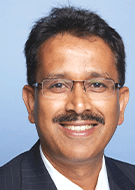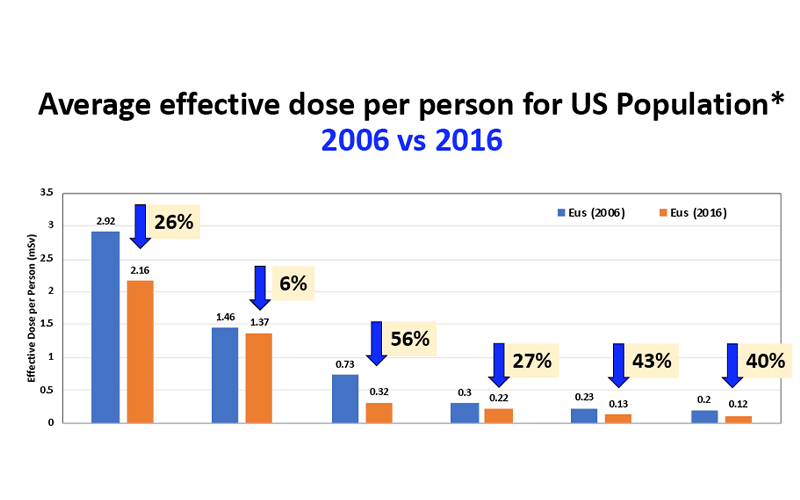Report Shows Average Medical Radiation Doses in U.S. are Decreasing
A Radiology Special Report highlights findings on dramatic drop in U.S. radiation dose in the past decade



Average diagnostic and interventional medical radiation doses have decreased in the last decade in the U.S., according to a 2019 National Council on Radiation Protection and Measurements (NCRP) report. Results of the NCRP report, showing a 15% to 20% reduction in medical radiation doses in the U.S. population from 2006 to 2016, are outlined in a March Radiology Special Report.
Findings from the report were presented at RSNA 2019 by Mahadevappa Mahesh, MS, PhD, a professor of radiology and medicine at the Johns Hopkins University School of Medicine, Baltimore, MD, shortly after the report was released in November 2019.
“The 2019 NCRP report demonstrates that medical radiation dose in the U.S. is on the decline, which is a positive shift from a decade ago when doses were increasing significantly,” Dr. Mahesh said. “Clearly, the medical community can continue to leverage the benefits of radiological procedures for patients while reducing dose.”
Dr. Mahesh co-chaired the NCRP report committee with Fred Mettler Jr., MD, professor emeritus and clinical professor at the Department of Radiology and Nuclear Medicine at the University of New Mexico School of Medicine. Drs. Mahesh and Mettler are authors on the Radiology Special Report offering a summary and highlights of the NCRP report. The report, which analyzed radiation exposure in the U.S. population from 2006 to 2016, serves as a 10-year update to a 2009 NCRP report that measured medical radiation exposure from the early 1980s to 2006.
According to the 2009 NCRP report, medical radiation exposure constituted nearly half of the total radiation exposure of the U.S. population. In fact, the 2009 report showed that medical radiation exposure increased nearly sixfold since the previous NCRP report, published in 1987 — a change primarily linked to the significant increase in use of CT.
By contrast, the 2019 report shows a dramatic decrease in average radiation dose per person – by as much as 15% to 20%. Specifically, in nuclear medicine, radiation dose per person was reduced by over 50%, mostly due to a decreasing number of procedures. “As for CT procedures, while the number of CT scans increased by 20% over the decade between the reports, the overall dose per CT exam declined,” Dr. Mahesh said. “
A major strength of this 2016 analysis is that the methodology and major data sources are largely the same as were used in the 2006 NCRP analysis, allowing for accurate comparison and clear identification of trends,” the Radiology authors write.

Technology, Increased Awareness Contribute to Dose Drop
What’s behind this decrease in dosage? According to Dr. Mahesh, several factors are at play. “One important change is the technological advances that have yielded hardware improvements and protocols, leading to higher quality images at lower doses,” he said. “Furthermore, the shift away from standard film and increased use of digital receptors in radiology has resulted in lower radiation doses for some procedures.”
Another contributing factor is the effort by agencies like the U.S. Food and Drug Administration and dose reduction campaigns such as Image Wisely® to raise public awareness, lower the amount of radiation used in medically necessary imaging studies and eliminate unnecessary procedures. Image Wisely was founded in 2010 by RSNA, the American College of Radiology (ACR) and other radiology organizations. Image Gently®, founded in 2007 by the Society of Pediatric Radiology, raises awareness of the opportunities to lower radiation dose in the imaging of children.
“The Image Wisely campaign set out to get everybody — from the radiologists to the technologists and the industry — to pay more attention to dose,” said Elliot Fishman, MD, professor of radiology and oncology at the Johns Hopkins University School of Medicine in Baltimore and co-chair of the RSNA/ACR Image Wisely Executive Committee. “Not only is the NCRP report good news, it’s proof that when we all work together toward a common goal, great things can happen for our patients.”
While Dr. Mahesh agrees that the decrease in radiation dosage is a good thing, he cautions that reducing dosages should not be a unilateral decision. “We have to keep the image quality intact,” he said. “If the image quality is jeopardized, all of our efforts toward reducing dosage are wasted because the study will have to be repeated.”
AAPM Revises Shielding Recommendations
The overall decrease in dosage rates, combined with advancing technology, is having an immediate impact on both radiology and patient care.
For example, some medical groups are beginning to recommend limiting the long-standing practice of patient shielding, in which lead aprons are used to shield patients from radiation exposure during X-rays.
Last year, the American Association of Physicists in Medicine (AAPM) released a position statement recommending limiting the routine use of fetal and gonadal shielding in the medical imaging of patients. This position has since been endorsed by numerous medical organizations, including RSNA and ACR.
In the next year, the NCRP is expected to release a statement that will provide guidance about the continued use of patient gonadal shielding, according to Rebecca Marsh, PhD, a medical physicist at the University of Colorado Anschutz Medical Campus, and chair of the AAPM Committee on Education and Implementation Efforts for Discontinuing the Use of Patient Gonadal and Fetal Shielding.
Dr. Marsh also notes some of the potential risks associated with shielding patients. “For example, a shield could cover anatomy that the physician needs to see, requiring the imaging process be repeated. There is also a concern that continued use of shielding may unnecessarily perpetuates the public’s fear of radiation — even when, as the NCRP report demonstrates, dosages are lower than ever.”
While lower dose rates cited in the NCRP report are not the only reason for this shift, that is a contributing factor, said Dr. Marsh, co-author of the 2019 American Journal of Roentgenology study, “Patient Shielding in Diagnostic Imaging: Discontinuing a Legacy Practice.”
“On one hand, we are using a lot less radiation in imaging than we used to,” Dr. Marsh said. “On the other hand, our understanding about the effects of radiation has evolved, with decades of studies showing no evidence of a genetic risk in humans.”
“Add to this the fact that doses are lower than ever, and it’s easy to see that the benefits of shielding simply no longer outweigh the associated risks,” she said.
For More Information
Access the full NCRP report at ncrponline.org.
Access the Radiology study, “Patient Exposure from X-ray and Nuclear Medicine Procedures in the United States: Procedure Volume and Effective Dose for the Period 2006-2016.”
Access the American Journal of Roentgenology study, “Patient Shielding in Diagnostic Imaging: Discontinuing a Legacy Practice,” at ajronline.org.
For more information on Image Wisely, go to ImageWisely.org; access the Image Gently campaign at ImageGently.org.